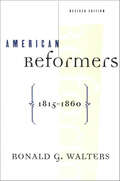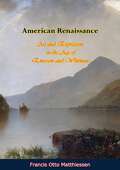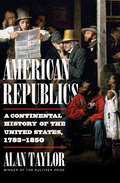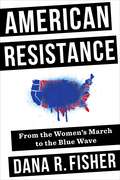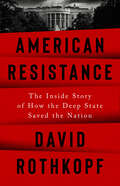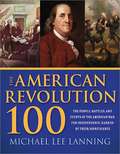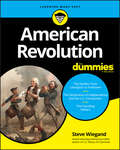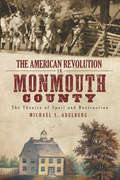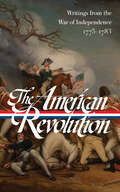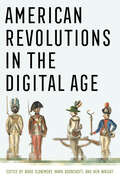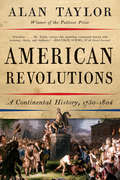- Table View
- List View
American Reed Organ and the Harmonium
by Robert F. GellermanCovers the history, construction, manufacturing, tuning, restoration, and music of these classic American and European parlor instruments.
American Reformers, 1815–1860
by Ronald G. WaltersFor this new edition of American Reformers 1815-1860, Ronald G. Walters has amplified and updated his exploration of the fervent and diverse outburst of reform energy that shaped American history in the early years of the Republic. Capturing in style and substance the vigorous and often flamboyant men and women who crusaded for such causes as abolition, temperance, women's suffrage, and improved health care, Walters presents a brilliant analysis of how the reformers' radical belief that individuals could fix what ailed America both reflected major transformations in antebellum society and significantly affected American culture as a whole.
American Religion, American Politics: An Anthology
by Jon Butler Joseph Kip KosekEssential primary sources reveal the central tensions between American politics and religion throughout the nation’s history Despite the centrality of separation of church and state in American government, religion has played an important role in the nation’s politics from colonial times through the present day. This essential anthology provides a fascinating history of religion in American politics and public life through a wide range of primary documents. It explores contentious debates over freedom, tolerance, and justice, in matters ranging from slavery to the nineteenth-century controversy over Mormon polygamy to the recent discussions concerning same-sex marriage and terrorism. Bringing together a diverse range of voices from Protestant, Catholic, Jewish, Muslim, and secular traditions and the words of historic personages, from Thomas Jefferson, Abraham Lincoln, and Frances Willard to John F. Kennedy and Martin Luther King, Jr., this collection is an invaluable introduction to one of the most important conversations in America’s history.
American Religion: The Emergence of the Postchristian Nation
by Harold BloomHow America has developed unique religious groups.
American Religions: A Documentary History
by R. Marie GriffithReligion has played a complex, vibrant, and multifaceted role in our nation's history. One of the most effective ways to help students explore its vitality is through primary sources. American Religions: A Documentary History is the only one-volume, up-to-date collection of primary sources available for American religious history courses. Featuring a creative dual structure--the readings are arranged both chronologically and thematically--this indispensable sourcebook can be used in both historically and topically organized courses. Balancing canonical works with those by newly discovered voices, American Religions: A Documentary History includes seventy-five classic and contemporary selections from the colonial period through the present day. It offers readings by a uniquely wide range of religiously, socially, and ethnically diverse writers: theological conservatives and liberals, northerners and southerners, women and men, and African Americans and Mexican Americans alongside Anglo-Americans. The selections are long enough to stimulate serious discussion yet concise enough for students to digest easily. The volume is organized into six sections that cover different chronological periods, each of which contains writings on five themes: theological reflections, ritual and performance, spiritual autobiography, interreligious conflict and negotiation, and more expansive conceptualizations of religion. Enhanced by brief biographies of the authors, a general introduction, and section introductions, the text also includes two sample syllabi--one oriented toward a historical approach and the other toward a thematic approach. Ideal for introductory courses in religion in America and American religious history--taught both in religious studies and history departments--American Religions: A Documentary History offers students a broad yet in-depth and engaging gateway into the subject.
American Religions: An Illustrated History
by J. Gordon MeltonMelton (Institute for the Study of American Religion, Santa Barbara, California) begins with over 400 native religions being practiced at the time of European contact. He then discusses the initial colonization and religious pioneers, how religious groups dealt with their new dependence on voluntary member support and the forces leading to the Civil War, the emergence of fundamentalism and its development up to current controversies, and the leap in religious pluralism at the end of the 20th century.
American Religious Liberalism (Religion in North America)
by Leigh E. Schmidt and Sally M. PromeyAn enlightening look at the surprising connections between spirituality and progressive thought in the United States. Religious liberalism in America is often associated with an ecumenical Protestant establishment. This book, however, draws attention to the broad diversity of liberal cultures that shapes America&’s religious movements. The essays gathered here push beyond familiar tropes and boundaries to interrogate religious liberalism&’s dense cultural leanings by looking at spirituality in the arts, the politics and piety of religious cosmopolitanism, and the interaction between liberal religion and liberal secularism. Readers will find a kaleidoscopic view of many of the progressive strands of America&’s religious past and present in this richly provocative volume.
American Religious Thought
by William A. ClebschThis book presents the broad current of religious dissent as a pervasive, although often hidden and ignored, stream in American life.
American Renaissance: Art and Expression in the Age of Emerson and Whitman
by Francis Otto MatthiessenThis text has taken its place as the definitive treatment of the most distinguished age of American literature. Centering the discussion around five literary giants of the mid-nineteenth century—Emerson, Thoreau, Hawthorne, Melville, and Whitman. Matthiessen elucidates their conceptions of the nature and function of literature, and the extent to which these were realized in their writings.
American Republic Since 1877 (Texas Edition)
by Mcgraw-Hill StaffWelcome to United States History Since Reconstruction and The American Republic Since 1877. This course completes the two-year study of American history that you began in Grade 8. The content of the high school course focuses on the political, economic, and social events that have shaped modern America.
American Republics: A Continental History Of The United States, 1783-1850
by Alan TaylorA Publishers Weekly Most Anticipated Book of Spring 2021 From a Pulitzer Prize–winning historian, the powerful story of a fragile nation as it expands across a contested continent. In this beautifully written history of America’s formative period, a preeminent historian upends the traditional story of a young nation confidently marching to its continent-spanning destiny. The newly constituted United States actually emerged as a fragile, internally divided union of states contending still with European empires and other independent republics on the North American continent. Native peoples sought to defend their homelands from the flood of American settlers through strategic alliances with the other continental powers. The system of American slavery grew increasingly powerful and expansive, its vigorous internal trade in Black Americans separating parents and children, husbands and wives. Bitter party divisions pitted elites favoring strong government against those, like Andrew Jackson, espousing a democratic populism for white men. Violence was both routine and organized: the United States invaded Canada, Florida, Texas, and much of Mexico, and forcibly removed most of the Native peoples living east of the Mississippi. At the end of the period the United States, its conquered territory reaching the Pacific, remained internally divided, with sectional animosities over slavery growing more intense. Taylor’s elegant history of this tumultuous period offers indelible miniatures of key characters from Frederick Douglass and Sojourner Truth to Elizabeth Cady Stanton and Margaret Fuller. It captures the high-stakes political drama as Jackson and Adams, Clay, Calhoun, and Webster contend over slavery, the economy, Indian removal, and national expansion. A ground-level account of American industrialization conveys the everyday lives of factory workers and immigrant families. And the immersive narrative puts us on the streets of Port-au-Prince, Mexico City, Quebec, and the Cherokee capital, New Echota. Absorbing and chilling, American Republics illuminates the continuities between our own social and political divisions and the events of this formative period.
American Resistance: From the Women's March to the Blue Wave
by Dana R. FisherSince Donald Trump’s first day in office, a large and energetic grassroots “Resistance” has taken to the streets to protest his administration’s plans for the United States. Millions marched in pussy hats on the day after the inauguration; outraged citizens flocked to airports to declare that America must be open to immigrants; masses of demonstrators circled the White House to demand action on climate change; and that was only the beginning. Who are the millions of people marching against the Trump administration, how are they connected to the Blue Wave that washed over the U.S. Congress in 2018—and what does it all mean for the future of American democracy? <P><P>American Resistance traces activists from the streets back to the communities and congressional districts around the country where they live, work, and vote. Using innovative survey data and interviews with key players, Dana R. Fisher analyzes how Resistance groups have channeled outrage into activism, using distributed organizing to make activism possible by anyone from anywhere, whenever and wherever it is needed most. Beginning with the first Women’s March and following the movement through the 2018 midterms, Fisher demonstrates how the energy and enthusiasm of the Resistance paid off in a wave of Democratic victories. She reveals how the Left rebounded from the devastating 2016 election, the lessons for turning grassroots passion into electoral gains, and what comes next. American Resistance explains the organizing that is revitalizing democracy to counter Trump’s presidency.
American Resistance: The Inside Story of How the Deep State Saved the Nation
by David RothkopfIt could have been so much worse: a deeply reported, insider story of how a handful of Washington officials staged a daring resistance to an unprecedented presidency and prevented chaos overwhelming the government and the nation. Each federal employee takes an oath to &“support and defend the Constitution of the United States against all enemies foreign and domestic,&” but none had imagined that enemy might be the Commander-in-Chief. With the presidency of Donald Trump, a fault line between the president and vital forces within his government was established. Those who honored their oath of office, their obligation to the Constitution, were wary of the president and they in turn were not trusted and occasionally fired and replaced with loyalists. American Resistance is the first book to chronicle the unprecedented role so many in the government were forced to play and the consequences of their actions during the Trump administration. From Lt. Col. Alexander Vindman and his brother Yevgeny, to Ambassador Marie Yovanovitch, to Bill Taylor, Fiona Hill, and the official who first called himself &“Anonymous&”—Miles Taylor, among others, Rothkopf examines the resistance movement that slowly built in Washington. Drawing from first hand testimonies, deep background and research, American Resistance shows how when the President threatened to run amok, a few key figures rose in defiance. It reveals the conflict within the Department of Justice over actively seeking instances of election fraud and abuse to help the president illegally retain power, and multiple battles within the White House over the influence of Jared and Ivanka, and in particular the extraordinary efforts to get them security clearances even after they were denied to them. David Rothkopf chronicles how each person came to realize that they were working for an administration that threatened to wreak havoc – one Defense Secretary was told by his mother to resign before it was too late – in an intense drama in which a few good men and women stood up to the tyrant in their midst.
American Revolution (SparkNotes History Notes)
by SparkNotesAmerican Revolution (SparkNotes History Note) Making the reading experience fun! Created by Harvard students for students everywhere, SparkNotes is a new breed of study guide: smarter, better, faster. Geared to what today's students need to know, SparkNotes provides: chapter-by-chapter analysis explanations of key themes, motifs, and symbols a review quiz and essay topics Lively and accessible, these guides are perfect for late-night studying and writing papers.
American Revolution 100: The Battles, People, and Events of the American War for Independence, Ranked by Their Significance
by Michael Lee LanningA controversial ranking of the Revolution's biggest battles, events, and leaders. The American Revolution 100 brings you onto the charred battlefields and inside the maneuverings of the war that produced America. In comprehensive fashion it explains, analyzes, and ranks the war's most significant events, leaders, and battles according to their importance. Celebrated veteran and military expert Michael Lee Lanning introduces the war's various causes and primary players. The 100 ranked entries that follow include bloody battles, outspoken politicians, military heroes, causes of the conflict, and monumental events. The War of Independence pitted king against colonialist, monarchy against democracy. Men risked execution for treason in order to bring about the model government that would inspire a world. The American Revolution 100 brings to life its battles, people, and events, including maps and illustrations.
American Revolution And Constitution: Short Nonfiction For American History (Toolkit Texts)
by Stephanie Harvey Anne Goudvis52 short nonfiction texts for American History (1750-1800) with 10 new lessons for content literacy <P><P>"We turn information into knowledge by thinking about it. These texts support students in using the Toolkit's comprehension and thinking strategies as tools to acquire and actively use knowledge in history." -Stephanie Harvey and Anne Goudvis <P><P> To support cross-curricular strategy instruction and close reading for information, Stephanie Harvey and Anne Goudvis have expanded their Toolkit Texts series to include a library of short nonfiction for American history with 10 all-new Toolkit lessons. <P><P> Building on selections from popular children's magazines as well as original articles, these engaging, age-appropriate texts will keep your active literacy classroom awash in historical resources that depict the controversies, issues, and dramas that shaped historical events, including the exploits of lesser-known individuals. <P><P> These short nonfiction texts for American history include: <P> 10 comprehension strategy lessons for close reading in content literacy. Short nonfiction articles on a wide range of topics and at a variety of reading levels. ( 45 articles in Colonial Times and 52 articles in The American Revolution and Constitution ) A bank of historical images, primary source documents and artifacts, plus primary source documents and artifacts bibliographies, web sites, and ideas for online investigations. A Digital Companion Resource provides all of the texts, primary source documents, and the image bank in a full-color digital format so you can display them for group analysis. Lesson Title 1 Read and Annotate: Stop, think, and react using a variety of strategies to understand 2 Annotate Images: Expand understanding and learning from visuals 3 Build Background to Understand a Primary Source: Read and paraphrase secondary sources to create a context for a topic 4 Read and Analyze a Primary Source: Focus on what you know and ask questions to clarify and explain 5 Compare Perspectives: Explore the different life experiences of historical figures 6 Read Critically: Consider point of view and bias 7 Organize Historical Thinking: Create a question web 8 Read with a Question in Mind: Focus on central ideas 9 Surface Common Themes: Infer the big ideas across several texts 10 Synthesize Information to Argue a Point: Use claim, evidence, and reasoning The CCSS and other state standards expect that children will read a variety of texts on a common topic and synthesize the ideas and information. <P><P> These short nonfiction texts were selected using the following criteria: Interest/Content Because kids love the quirky and the unexpected, these texts highlight important but often lesser-known or unrecognized perspectives and voices from the past. Visual literacy Since visual literacy is an essential 21st-century skill, these texts include historical images, paintings, and maps, as well as diagrams, timelines, charts, and photographs. Writing quality and accuracy To foster student engagement, these articles feature vibrant language in an active voice supported by a rich assortment of visual features. Reading level/complexity These texts are written at a range of reading levels and include a wide variety of topics to capture the interests of all readers.
American Revolution For Dummies
by Steve WiegandBecome an expert on the Revolutionary War American Revolution For Dummies capitalizes on the recent resurgence of interest in the Revolutionary War period—one of the most important in the history of the United States. From the founding fathers to the Declaration of Independence, and everything that encapsulates this extraordinary period in American history, American Revolution For Dummies is your one-stop guide to the birth of the United States of America. Understanding the critical issues of this era is essential to the study of subsequent periods in American history … and this book makes it more accessible than ever before. Covers events leading up to the war, including the Sugar Act, Stamp Act, and the Boston Tea Party Provides information on The Declaration of Independence Offers insight on major battles, including the Battles of Lexington and Concord, Bunker Hill, and Yorktown Reviews key figures, including George Washington, Charles Cornwallis, the Marquis de Lafayette, and Alexander Hamilton If you want or need to become more knowledgeable about the American War of Independence and the people and period surrounding it, this book gives you the information necessary to become an expert on the essential details of the revolutionary period.
American Revolution in Monmouth County, The: The Theatre of Spoil and Destruction (Military)
by Michael S. AdelbergLike much of New Jersey during the American Revolution, Monmouth County was contested territory in between the great armies. As the Battles of Trenton, Princeton and Bound Brook raged nearby, the people of Monmouth County fought their own internal revolution; Loyalist partisans led insurrections and raids that laid waste to entire neighborhoods. In 1778, General George Washington rallied his Continental army and fought the British within Monmouth's borders, barely holding the field. Monmouth Countians joined the fight and then spent the following weeks caring for the wounded and burying the dead. The remaining war years brought more hardships, as they grappled with a local civil war charged with racial, religious and economic undercurrents--a local civil war that continued long after the Battle of Yorktown supposedly ended hostilities. Revolutionary War scholar Michael S. Adelberg brings to life the struggles within Monmouth County, a place that New Jersey governor William Livingston called "the theatre of spoil and destruction."
American Revolution, 1700-1800 (Chronicle of America Series)
by Joy MasoffThe second volume of the Chronicle of America series examines the American Revolution, describing life in the colonies during the years between 1700 and 1800, when the colonists were struggling to establish their independence from Great Britain.
American Revolution: A Complete Toolkit With Background Information, Primary Sources, And More That Help Students Build Reading And Writing Skills-and Deepen Their Understanding Of History
by Renay M. ScottWhat better way to learn about history than to relive it? Students assume the roles of colonists, patriots, and loyalists as they participate in a weeklong simulation that takes them through the events that led to and ended the American Revolution. Includes easy step-by-step directions, plus reproducible student worksheets, tables, maps, and rubrics-everything you need to run a successful simulation! For use with Grades 5 & Up.
American Revolution: A Nonfiction Companion to Revolutionary War on Wednesday
by Mary Pope OsborneWHY DID WE fight the Revolutionary War? What is the Declaration of Independence? What was it like to live in the 13 colonies? Find out the answers to these questions and more in Magic Tree House Research Guide: American Revolution, Jack and Annie's guide to one of the most important events in our nation's history. This is the nonfiction companion to Revolutionary War on Wednesday(Magic Tree House #22). "A great place to begin research for a report."--School Library Journal
American Revolution: Reader (Amplify Core Knowledge Language Arts, Grade 4 #Unit 7)
by Amplify EducationNIMAC-sourced textbook
American Revolution: Writings from the War of Independence
by Various John H. RhodehamelOne of the Library of America's editions of historic writings, this is a collection of papers from the Revolutionary period. It starts with Paul Revere's own account of his famous ride in 1775 and ends with a description of George Washington's resignation from the Continental Army in 1783. Journal entries, letters, newspaper articles, and public documents are included, written by Revolutionary leaders, soldiers and their wives, British officers, and Colonial loyalists. Annotation copyrighted by Book News Inc. , Portland, OR
American Revolutions in the Digital Age
by Ben Wright Mark Boonshoft Nora SlonimskyThe interdisciplinary essays in American Revolutions in the Digital Age explore what digital tools can tell us about the late eighteenth- and early nineteenth-century United States and reveal how an understanding of the American past can make sense of our digital present. By employing a host of innovative digital research methods, these authors challenge long-held assumptions about the American past. In addition, this collection uniquely demonstrates how contemporary anxieties about an array of topics, including media disinformation, patriarchy, economic inequality, and public memory, can be better understood through careful considerations of early American history.Open Access edition funded by Iona University
American Revolutions: A Continental History, 1750 - 1804
by Alan Taylor“Excellent . . . deserves high praise. Mr. Taylor conveys this sprawling continental history with economy, clarity, and vividness.”—Brendan Simms, Wall Street Journal The American Revolution is often portrayed as a high-minded, orderly event whose capstone, the Constitution, provided the nation its democratic framework. Alan Taylor, a two-time Pulitzer Prize winner, gives us a different creation story in this magisterial history. The American Revolution builds like a ground fire overspreading Britain’s colonies, fueled by local conditions and resistant to control. Emerging from the continental rivalries of European empires and their native allies, the revolution pivoted on western expansion as well as seaboard resistance to British taxes. When war erupted, Patriot crowds harassed Loyalists and nonpartisans into compliance with their cause. The war exploded in set battles like Saratoga and Yorktown and spread through continuing frontier violence. The discord smoldering within the fragile new nation called forth a movement to concentrate power through a Federal Constitution. Assuming the mantle of “We the People,” the advocates of national power ratified the new frame of government. But it was Jefferson’s expansive “empire of liberty” that carried the revolution forward, propelling white settlement and slavery west, preparing the ground for a new conflagration.

